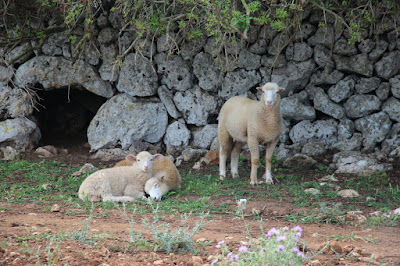Hey there!
We thought it was time for a challenge, so we planned on travelling across the island in one day, spending a few days in the western part of Menorca (near Ciutadella) and eventually cycling back to the capital Maó one day prior to our departure.
 |
| Rocky Road |
What a plan!
 |
| https://goo.gl/Q2gwGj |
But this... this was our return route. On the way to Ciutadella we biked along the southern coast.
We started our journey at 10 am - we thought if we headed off this early, we would have a few hours of the day left to explore the surroundings of our accomodation in Cala Blanca (we were wrong!).
From Maó we headed to Cala en Porter. First we cycled on the motorway, next to friendly car drivers, who always left sufficient space for us to ride our bikes. After a while we turned off the motorway and onto a narrow rural road leading us downward through the hills past orchards and eventually onto a more challenging stoney path. From the first cove onwards we only travelled along the sea. Which was extremely beautiful and impressive, however it was also extremely challenging and energy/time-consuming.
We passed numerous gates made of olive wood, lots of flowers, some orchards and magnificent coves and beaches.
 |
| One of the bikes and our baggage |
We passed numerous gates made of olive wood, lots of flowers, some orchards and magnificent coves and beaches.
Along the way we once lost a few belongings (luckily a friendly kindergarten group picked them up and gave them to us in the neighbouring bay) and had to constantly motivate ourselves to keep on cycling. By the way - we had never done a mountain bike tour before, so we were absolute beginners travelling with mountain bikes. At times it was very steep, as you can see in the photo.
We only travelled with small backpacks and a camera - to save the extra fee on the plane and because we wouldn't have been able to do such a tour with a suitcase anyway - which is another point for the disadvantages of excess baggage.
When we arrived at Son Bou, we had to push our bikes through sand, as we were too lazy to take a detour inland, which made us very tired. But the view definitely made up for the tiredness.
After the sandy part, we cycled a while through the colder forest. It was great to move forward in the shade, since we had been in the blazing sun for more than 6 hours.
Also we thought it was beautiful to see so many different faces of Menorca. We had seen a rocky landscape, agricultural areas, dunes, beaches and forests when we finished the tour.
At one point we got lost.
This is the last photo we took at 6.38 pm. After that all we wanted was to arrive at Cala Blanca, where we would be staying for the next few days.
Also we thought it was beautiful to see so many different faces of Menorca. We had seen a rocky landscape, agricultural areas, dunes, beaches and forests when we finished the tour.
At one point we got lost.
This is the last photo we took at 6.38 pm. After that all we wanted was to arrive at Cala Blanca, where we would be staying for the next few days.
We had been cycling through the forest for a while and our GPS track told us to keep cycling. We ended up at a lonely beach; no road or civilisation in sight. Our "trustful" track meant to lead us to a path that started a few feet up the cliff line - impossible to reach for us, especially with our MTBs.
That was the breaking point.
That was the breaking point.
I thought for a few seconds I would most likely die there, since we didn't have any signal, battery nor a few drops of water. (Have you seen the film Into the Wild? If not, watch it and you'll understand.)
However we kept on trying; back up the hill where we came from and through the forest again; somehow westward.
Miraculously we eventually arrived in Cala Galdana (not our final destination) at 9 or 10 pm. The sun had already set, we were hungry and wondered where we could sleep.
We couldn't possibly keep on cycling, as we didn't have lights attached to our bikes and our energy level was close to zero as well.
The only solution was to be picked up by a taxi. We were really lucky in the end, because our driver knew how to demount bikes making it easy to fit them in the boot of the car.
At 11 pm we arrived at our accomodation, drank lots of water and fell onto the most comfortable bed on earth.
More to come!
Steph (still owning the travel bug, despite this adventurous day)

























































